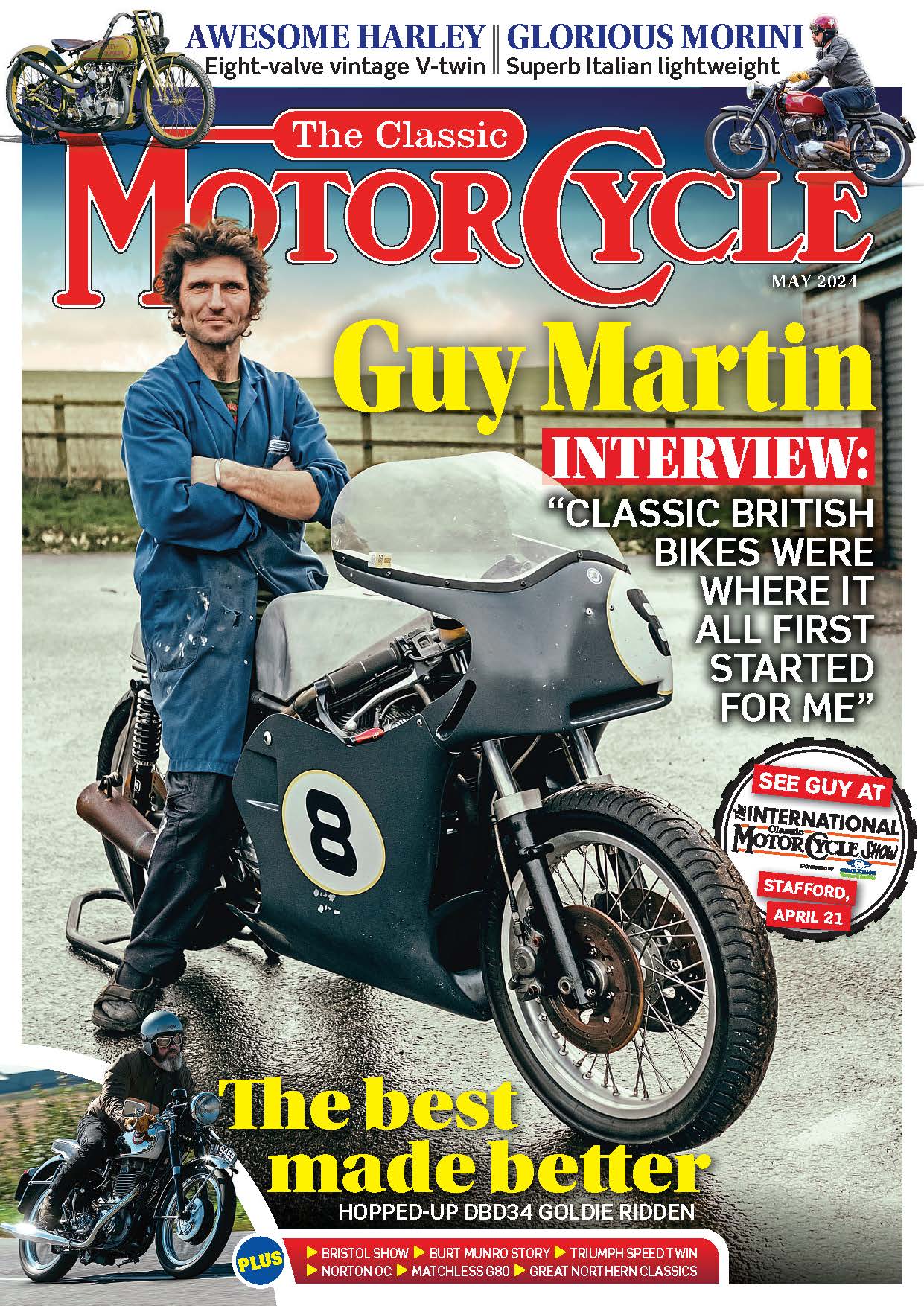
Road test reports should always do more than simply confirm facts or support existing prejudices, so you hopefully won’t find me saying a Vincent Black Lightning is lightning fast or a Norman Nippy’s designation is close to contravening the Trades Description Act (I’ll admit to indulging in the occasional play on words). Instead, I’m on the lookout for aspects that might surprise and interest non-owners, such as the fact a Vincent is surprisingly neat and compact from a rider’s perspective, or that a classic moped is still a practical means of getting about town.
That’s why there’s always plenty to say about post-WWII Royal Enfields. Because even today they suffer from misinformed criticism stemming from a vicious circle where reservations about their slight unorthodoxy curbed their sales, so they never reached the tipping point where enough people could experience them to realise that those concerns were largely unfounded.
Enjoy more Classic MotorCycle reading in the monthly magazine.
Click here to subscribe & save.
 To prove my point, I imagine many motorcyclists – whatever their preferred marque – will look at the photographs of this Enfield Continental and think it is a pretty little bike, but I’d be surprised if anybody instantly considered going out to try one or buy one. Well I’m here to tell them they may be missing out on a lot of fun, but I’ll also admit that some of the clubhouse gossip and prejudice is actually true.
To prove my point, I imagine many motorcyclists – whatever their preferred marque – will look at the photographs of this Enfield Continental and think it is a pretty little bike, but I’d be surprised if anybody instantly considered going out to try one or buy one. Well I’m here to tell them they may be missing out on a lot of fun, but I’ll also admit that some of the clubhouse gossip and prejudice is actually true.
No, I’m not talking about the oil leaks, although Enfields admittedly had their problems in that respect. It’s the gearbox on certain small single-cylinder models that really does match its poor reputation. In 1961 the Redditch factory made history by producing the Super 5; the first British production motorcycle with a five-speed gearbox. Unfortunately, the cogs had to be shoehorned into the same space as the previous four speeds, so they were drastically slimmed down and the selector mechanism consequently needed to be much more accurate than hitherto. Sadly it wasn’t! Constrictions on space and development effort, compounded by manufacturing imprecision, (and, to be fair, by limitations in young riders’ mechanical sympathy and maintenance ability) meant that all of the gears seldom remained available for long. The problems were so deep rooted that many enthusiasts have retro-fitted their machines with the old four-speed cluster, while more ambitious owners have developed better selector mechanisms.
The Royal Enfield Continental I’m riding today currently resides in the premises of respected North Wiltshire classic dealer Bill Little and came with a significant amount of documentation that includes a club certificate of authenticity, and outlines its evidently complicated history. According to the plate on the rear mudguard it was originally supplied by Kings of Market Buildings, Leigh (without specifying which of Britain’s numerous Leighs that was) and it subsequently had several owners and spent quite a time in Wales before its restoration was completed and it was given a Gloucestershire age-related registration.
 The many invoices included in the documentation include a substantial one for rebuilding the gearbox, and a certain lack of confidence is indicated by a note from the engineer asking to be kept informed of the success of the venture. Well, he’ll be relieved to hear that all five gears were available during my ride, and I only found a false neutral once, when I pressed downwards a little too firmly. Admittedly the gearlever’s low pivot point gives it a slightly awkward up and back, down and forward, action, but you soon get used to that, and in compensation it has a delightfully short, light, movement (not surprising considering how closely the cogs are packed together). The other difficulty is that the proximity of gearlever and footrest is less suitable for old codgers with hefty boots, than for lightweight youngsters wearing winkle picker shoes.
The many invoices included in the documentation include a substantial one for rebuilding the gearbox, and a certain lack of confidence is indicated by a note from the engineer asking to be kept informed of the success of the venture. Well, he’ll be relieved to hear that all five gears were available during my ride, and I only found a false neutral once, when I pressed downwards a little too firmly. Admittedly the gearlever’s low pivot point gives it a slightly awkward up and back, down and forward, action, but you soon get used to that, and in compensation it has a delightfully short, light, movement (not surprising considering how closely the cogs are packed together). The other difficulty is that the proximity of gearlever and footrest is less suitable for old codgers with hefty boots, than for lightweight youngsters wearing winkle picker shoes.
But that’s exactly who the Continental was aimed at, and it was one of the few machines where teenagers could fit ‘L’ plates and still retain a bit of street cred. While other manufacturers either simply ignored younger riders, or just added a bit of chrome to their existing commuting machines, Royal Enfield actually took note of what the lads wanted and provided it. The process, of course, peaked famously in 1965 with the GRP-tanked Continental GT, but as you’d expect from its name, the original Continental that appeared two years earlier was an important stepping stone along the way.
 All of Enfield’s unit-construction single cylinder bikes were descended from the Crusader that made its bow in 1956. It was totally unlike its predecessors – apart from carrying its oil in a crankcase compartment – and in fact it was different from anything else on the market in several respects. The credit for its layout goes to young draughtsman Reg Thomas, working under the supervision of Enfield’s Chief Engineer Tony Wilson Jones, and perhaps it was Thomas’s youth that encouraged him to break with tradition in several respects.
All of Enfield’s unit-construction single cylinder bikes were descended from the Crusader that made its bow in 1956. It was totally unlike its predecessors – apart from carrying its oil in a crankcase compartment – and in fact it was different from anything else on the market in several respects. The credit for its layout goes to young draughtsman Reg Thomas, working under the supervision of Enfield’s Chief Engineer Tony Wilson Jones, and perhaps it was Thomas’s youth that encouraged him to break with tradition in several respects.
The electrics were provided by an alternator – itself quite modernistic at the time – and sensibly but unusually it was situated on the right, well away from its conventional position in the oily mayhem of the primary chaincase. This led directly to the other main unorthodoxy of putting the camshaft and pushrods over on the left of the engine. Those prepared to consider the new bikes without prejudice, however, couldn’t fail to be impressed. Aided by the lack of external oil pipes the engine/gearbox unit was particularly neat, and despite its unitised nature it could be totally dismantled – except for removal of the crankshaft – while still in the frame. The cycle parts were equally impressive, the all-welded frame having proper telescopic forks and swinging arm rear suspension – by no means universally found on lightweights at the time – and the final chain drive was fully enclosed, which would have been remarkable on a large luxury motorcycle, let alone a lightweight. There was even a decent full-sized dual seat.
 Most importantly the engine produced 13 horsepower, and that put it head and shoulders above contemporaries like the BSA C12. Unfortunately, it was also considerably more expensive, and in those days when quarter litre jobs were mostly seen as ride-to work bikes, that did the Crusader no favours in the showroom.
Most importantly the engine produced 13 horsepower, and that put it head and shoulders above contemporaries like the BSA C12. Unfortunately, it was also considerably more expensive, and in those days when quarter litre jobs were mostly seen as ride-to work bikes, that did the Crusader no favours in the showroom.
Its day was soon to come, however, as the dreaded limitation of learners to 250s was on the horizon, and those that wanted a four-stroke of that capacity with sporting credentials and appropriate looks had a very limited choice. AMC’s Norton Jubilee and AJS/Matchless 14/G2 never really cut it in the styling stakes, and the C15 that replaced BSA’s venerable C12 was fairly obviously aimed at mature motorcyclists who wanted a traditional no-frills bike.
BSA’s economies of scale meant that the C15 was comparatively cheap however, and many youngsters bought one purely for that reason, spending some of their spare cash tuning them up with chequered tape. But Enfield’s Crusader held its own against the others in sales terms, and those who bought them certainly lost nothing to the opposition on the move, and undoubtedly won in the looks department.
 Redditch seized its opportunity, and development continued apace, and in 1959 there was a sports version of the Crusader, with a higher compression piston, lighter flywheel and alloy cylinder head that gave it a top speed of nearly 80mph, comfortably faster than most contemporary 350s, let alone its class competitors. The cycle parts were altered appropriately, too, and extra chromium was allied to slightly rear set footrests and dropped handlebars, to give an appearance and riding position that matched the performance.
Redditch seized its opportunity, and development continued apace, and in 1959 there was a sports version of the Crusader, with a higher compression piston, lighter flywheel and alloy cylinder head that gave it a top speed of nearly 80mph, comfortably faster than most contemporary 350s, let alone its class competitors. The cycle parts were altered appropriately, too, and extra chromium was allied to slightly rear set footrests and dropped handlebars, to give an appearance and riding position that matched the performance.
The mechanical improvements were soon passed on in various degrees to the other quarter litre models in the range (Enfield was always adept at mixing and matching) but then the company shot itself in the foot with the aforementioned five-speed gearbox on the Super Five; or Crusader Super 5 as it was actually catalogued. This was the first model to provide the magic 20bhp output, literally putting it even further ahead of the opposition, but its reputation and sales potential were soon dented by the gearbox’s reputation for unpredictably producing fewer ratios and extra neutrals. Even worse, in a way, was its use of leading link forks. Not that there was anything wrong with their behaviour, on the contrary they gave excellent handling and comfort, but they simply looked stylistically at odds with the rest of the bike.
But then in 1963 came the Continental, one of which I’m riding today, and it was obvious that the Redditch stylists had taken pains to provide exactly what their potential customers were looking for in a new lightweight motorcycle. Most noticeably, there was a new ‘jelly mould’ petrol tank with more than a nod towards the sort of thing seen on racy Italian jobs. True, it wasn’t especially practical, with its filler cap situated below the highest point so that its full capacity could never be used, and admittedly it was actually the same basic shape used by several other manufacturers on their rather less inspiring two-stroke twins, but here it looked the business with its chrome-plate sides and quick action Monza filler cap.
 Other appropriate styling touches included abbreviated chromed mudguards and the replacement of Enfield’s trademark headlamp nacelle with a separate chromed headlamp shell. The top fork yoke was still an aluminium casting but now it carried a rev counter alongside the speedometer, and that was the ultimate status symbol for would-be cafe racers – even ones still wearing ‘L’ plates. Even the chequered tape at the top of the forks was fitted by the factory, and if it served the dual purpose of cheaply preventing the otherwise-exposed stanchions from going rusty, prospective customers were probably too naive to realise that, and too bedazzled by the bling to care. Seventeen inch wheels were small by the norms of the day, but everything was so neatly in proportion that quarter-litre Enfields neither look nor feel unreasonably small.
Other appropriate styling touches included abbreviated chromed mudguards and the replacement of Enfield’s trademark headlamp nacelle with a separate chromed headlamp shell. The top fork yoke was still an aluminium casting but now it carried a rev counter alongside the speedometer, and that was the ultimate status symbol for would-be cafe racers – even ones still wearing ‘L’ plates. Even the chequered tape at the top of the forks was fitted by the factory, and if it served the dual purpose of cheaply preventing the otherwise-exposed stanchions from going rusty, prospective customers were probably too naive to realise that, and too bedazzled by the bling to care. Seventeen inch wheels were small by the norms of the day, but everything was so neatly in proportion that quarter-litre Enfields neither look nor feel unreasonably small.
Best of all, the Continental delivered what it promised, and riding this one I’m well impressed with just about everything. The slightly rear set footrests are ideally matched by Ace handlebars and a proper dual seat so that the riding position somehow manages to combine a compact, racy, forward leaning stance with excellent comfort. The front forks give good comfort with surprisingly precise steering considering their comparatively simple and virtually undamped nature (which the factory literature cunningly avoided mentioning by simply describing them as automatically lubricated) and the conventional rear swinging arm tracks well.
 The engine couldn’t be described as mechanically silent, but there are no worrying noises either, and the exhaust has a delightfully solid bark. More importantly, the motor punches well above its weight, with lusty pulling power allied to a willingness to rev that quickly has the speedo needle swinging round to 60mph, with quite a bit more to come. That feels like an accurate reading, but the tachometer needs a bit of TLC, as it indicates a tick-over of 3000rpm and zings off scale with every blip of the throttle. But hey, the instrument’s main function is cosmetic, and if you actually need a tachometer to tell you how much throttle to use, then you probably shouldn’t be riding a British classic. Strangely, assuming this is the original instrument, it is redlined at 6200rpm whereas the engine is reputedly safe for at least another thousand.
The engine couldn’t be described as mechanically silent, but there are no worrying noises either, and the exhaust has a delightfully solid bark. More importantly, the motor punches well above its weight, with lusty pulling power allied to a willingness to rev that quickly has the speedo needle swinging round to 60mph, with quite a bit more to come. That feels like an accurate reading, but the tachometer needs a bit of TLC, as it indicates a tick-over of 3000rpm and zings off scale with every blip of the throttle. But hey, the instrument’s main function is cosmetic, and if you actually need a tachometer to tell you how much throttle to use, then you probably shouldn’t be riding a British classic. Strangely, assuming this is the original instrument, it is redlined at 6200rpm whereas the engine is reputedly safe for at least another thousand.
Problems? Well, Enfield’s centrestands were never their best feature. The light alloy casting looks good, but it requires quite a heave to get even the smaller models up onto it, and then you find the stops have worn so that it goes over centre allowing both wheels to slump back down onto the ground. The steering lock is also much more restricted than you’d expect with such a neat machine, and you’d need to do a bit of shunting to park it in the garden shed.
It’s not a lot to complain about when set against impressive technical innovation, class leading performance and sparkling good looks, is it? The test machine will probably be in the hands of a lucky private owner by the time you read this, but I don’t mind admitting that I wouldn’t have needed much persuasion to be ‘doing the Continental’ myself. ![]()
Advert
 Enjoy more The Classic MotorCycle reading in the monthly magazine. Click here to subscribe.
Enjoy more The Classic MotorCycle reading in the monthly magazine. Click here to subscribe.











